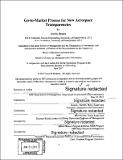| dc.contributor.advisor | Brian L. Wardle and Roy Welsch. | en_US |
| dc.contributor.author | Henson, Sean M. (Sean Michael) | en_US |
| dc.contributor.other | Leaders for Global Operations Program. | en_US |
| dc.date.accessioned | 2017-09-15T15:38:33Z | |
| dc.date.available | 2017-09-15T15:38:33Z | |
| dc.date.copyright | 2017 | en_US |
| dc.date.issued | 2017 | en_US |
| dc.identifier.uri | http://hdl.handle.net/1721.1/111537 | |
| dc.description | Thesis: M.B.A., Massachusetts Institute of Technology, Sloan School of Management, in conjunction with the Leaders for Global Operations Program at MIT, 2017. | en_US |
| dc.description | Thesis: S.M., Massachusetts Institute of Technology, Department of Aeronautics and Astronautics, in conjunction with the Leaders for Global Operations Program at MIT, 2017. | en_US |
| dc.description | Cataloged from PDF version of thesis. | en_US |
| dc.description | Includes bibliographical references (page 55). | en_US |
| dc.description.abstract | One challenge that many manufacturing companies face is the transition from lab-scale product development to full-scale production. Techniques and processes that are used by research and development (R&D) personnel or within a lab may not be suitable for a production environment, and directly applying an R&D process to production may overlook certain capabilities and requirements. This challenge can be made more difficult if there is a development "wall" between R&D and production. R&D personnel are familiar with new products and underlying technologies and have learned important lessons throughout the development process, while production personnel have experience with full-scale production and necessary manufacturing requirements. Getting these two groups to share knowledge and work together can be key to the successful industrialization of a new product or technology. Texstars is a Texas-based aerospace manufacturer that is currently transitioning a new transparency (optically clear structural material) product based on a polyurethane material technology branded TexeronTM, from R&D to production. TexeronTM provides a significant market opportunity to Texstars and its transition requires the development of new equipment and capabilities to reach full-scale production. This thesis examines the industrialization process of TexeronTM , including the definition of manufacturing requirements, the selection of equipment, and product-specific tooling design, and provides a working example of how a small company can balance production requirements with cost considerations. Throughout the project, we catalyzed a link between R&D and production personnel at Texstars to enable knowledge transfer. We find that this link could have been established earlier to better anticipate production challenges before production trials began. For future new product introductions, Texstars can initiate coordination between R&D and production and implement a product transition process as soon as a launch customer is identified. | en_US |
| dc.description.statementofresponsibility | by Sean M. Henson. | en_US |
| dc.format.extent | 55 pages | en_US |
| dc.language.iso | eng | en_US |
| dc.publisher | Massachusetts Institute of Technology | en_US |
| dc.rights | MIT theses are protected by copyright. They may be viewed, downloaded, or printed from this source but further reproduction or distribution in any format is prohibited without written permission. | en_US |
| dc.rights.uri | http://dspace.mit.edu/handle/1721.1/7582 | en_US |
| dc.subject | Sloan School of Management. | en_US |
| dc.subject | Aeronautics and Astronautics. | en_US |
| dc.subject | Leaders for Global Operations Program. | en_US |
| dc.title | Go-to-market process for new aerospace transparencies | en_US |
| dc.type | Thesis | en_US |
| dc.description.degree | M.B.A. | en_US |
| dc.description.degree | S.M. | en_US |
| dc.contributor.department | Leaders for Global Operations Program at MIT | en_US |
| dc.contributor.department | Massachusetts Institute of Technology. Department of Aeronautics and Astronautics | |
| dc.contributor.department | Sloan School of Management | |
| dc.identifier.oclc | 1003325049 | en_US |
